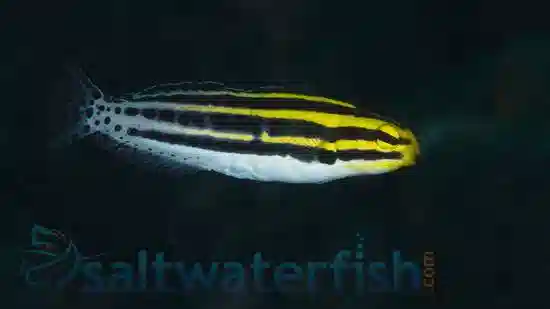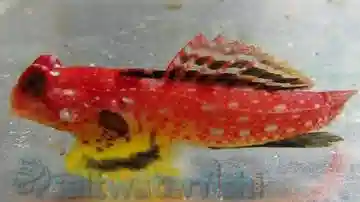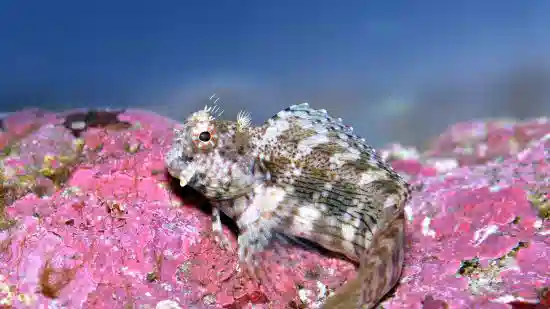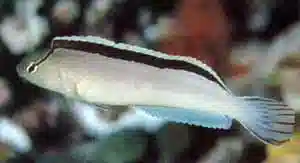Striped Blenny - Captive Bred
Meiacanthus grammistes
(1 Reviews)

Striped Blenny - Captive Bred
Meiacanthus grammistes
(1 Reviews)
{{ item.name }}
Size: {{ item.extra_field_3 }}
${{ getFormattedPrice(item.saleprice) }} ${{ getFormattedPrice(item.price) }}
To join the waiting list, click here
Free Shipping
With
$199.00
or more in Marine Life.
More details...
Striped Blenny - Captive Bred Care Facts
| Care Level: | Moderate |
|---|---|
| Temperament: | Peaceful |
| Diet: | Omnivore |
| Reef Safe: | Yes |
| Minimum Tank Size: | 30 gallons |
| Max Size: | 5 inches |
The Striped Blenny: A Fascinating Addition to Your Saltwater Aquarium
The Striped Blenny, scientifically known as Meiacanthus grammistes, is a fascinating addition to saltwater marine aquariums. Originating from the Indo-Pacific region, particularly the Coral Sea and Great Barrier Reef, this species inhabits reef environments characterized by rocky crevices and coral formations. Renowned for its vibrant colors and unique behaviors, the Striped Blenny is a popular choice among marine enthusiasts seeking to diversify their aquarium setups.
Habitat of the Striped Blenny
In their natural habitat, Striped Blennies are commonly found darting among coral branches and rocky outcrops, seeking refuge in crevices. Their preference for such environments makes them well-suited for aquariums with ample hiding places and suitable rock formations.
Reef Compatibility of the Striped Blenny
Considered reef-safe, Striped Blennies generally pose no threat to corals or other invertebrates. However, they may occasionally nip at small-polyped stony corals, especially if insufficient food is available. Proper feeding and a well-maintained environment can mitigate this behavior.
Size and Lifespan of the Striped Blenny
Typically reaching a size of around 5 inches in length, Striped Blennies are relatively small, making them suitable for a wide range of aquarium sizes. They can live up to 5 years or more in captivity with proper care.
Diet of the Striped Blenny in Captivity
Striped Blennies are omnivorous, primarily feeding on small crustaceans, zooplankton, and algae in the wild. In captivity, they readily accept a varied diet consisting of high-quality marine flakes, pellets, frozen foods, and live foods such as brine and mysis shrimp.
Aquaculture Availability of the Striped Blenny
While wild-caught specimens are occasionally available, aquacultured Striped Blennies are becoming increasingly common in the aquarium trade. Aquacultured specimens tend to be hardier and more adaptable to aquarium conditions, making them an ideal choice for hobbyists.
Compatibility of the Striped Blenny with Other Fish and Invertebrates:
Striped Blennies are generally peaceful towards other tank mates but may exhibit territorial behavior towards conspecifics or similar-looking species. Compatible tank mates include peaceful reef fish such as gobies, dartfish, and small wrasses. Avoid pairing them with aggressive or predatory species.
Sexual Dimorphism of the Striped Blenny
Sexual dimorphism in Striped Blennies is not readily apparent, as males and females exhibit similar coloration and morphology.
Juvenile to Adult Coloration Changes in the Striped Blenny
Juvenile Striped Blennies typically display more subdued coloration, with faint stripes along their body. Their colors become more vibrant as they mature, featuring distinct black and white stripes along their elongated body.
Temperament of the Striped Blenny
Striped Blennies are known for their curious and active behavior, often perching on rocks or coral branches to observe their surroundings. While generally peaceful, they may exhibit territorial behavior towards conspecifics or similarly shaped species.
Tank Requirements for the Striped Blenny
For optimal health and well-being, provide a minimum aquarium size of 30 gallons for a single Striped Blenny, with additional space recommended for larger groups or multiple species. Ensure ample hiding places among rocks and coral formations to mimic their natural habitat. Maintain stable water parameters, including pH between 8.1-8.4, salinity of 1.023-1.025, water temperature of 72-78°F (22-26°C), and moderate water flow.
Other Common Names for the Striped Blenny
The Striped Blenny may also be known by other common names, including Striped Fang Blenny and Striped Poison-fang Blenny.
Compatible Tank Mates For the Striped Blenny
Five compatible tank mates for the Striped Blenny include:
- Clownfish (e.g., Ocellaris Clownfish)
- Royal Gramma (Gramma loreto)
- Firefish (Nemateleotris spp.)
- Banggai Cardinalfish (Pterapogon kauderni)
- Orchid Dottyback (Pseudochromis fridmani)
Why Choose Saltwaterfish.com for Striped Blennies:
Saltwaterfish.com offers a wide selection of high-quality Striped Blennies sourced from reputable suppliers and aquaculture facilities. With focuses on sustainability and customer satisfaction, Saltwaterfish.com ensures that all marine life is healthy, vibrant, and ethically sourced. Additionally, their team of experts provides valuable resources and support to assist hobbyists in creating and maintaining thriving marine aquariums.
The Striped Blenny (Meiacanthus grammistes) is an engaging and visually striking addition to saltwater marine aquariums, allowing hobbyists to observe fascinating behaviors and vibrant colors. With proper care and suitable tank mates, these charismatic fish can thrive in a well-maintained aquarium environment, adding beauty and diversity to any reef setup.
A cute, little, lively Striped Blenny - Captive Bred that brings a lot of character to your tank. Seems to play well with others and makes a welcome addition while being an easy keeper.
Reviewed by: Melody Marshall on Sept. 11, 2021








